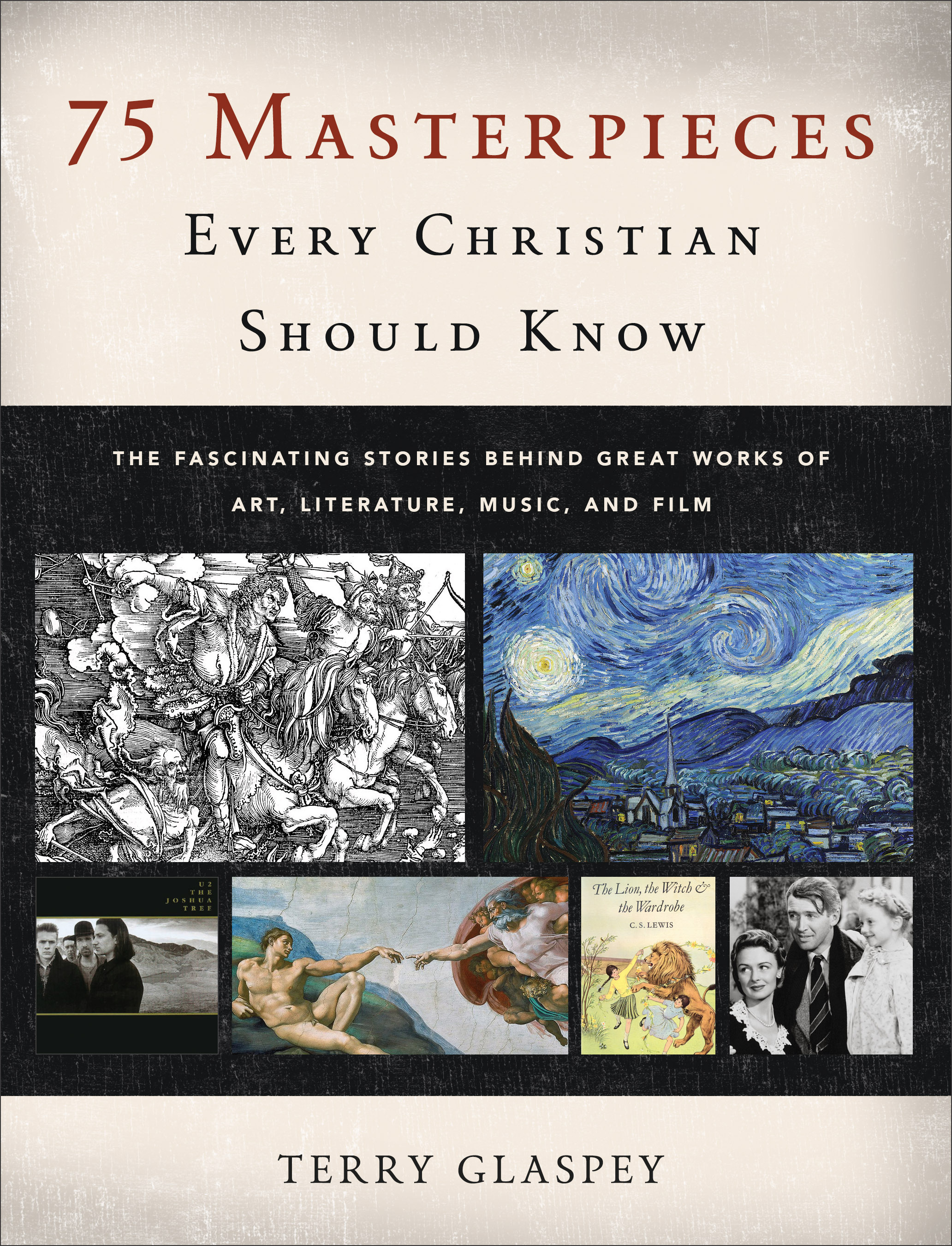75 Masterpieces
This week has been one marred by the loss of masters — C.D. Wright, David Bowie, Alan Rickman — artists whose work will be meaningful for many generations to come.
We don't remember them for the originality of their "messages" or "themes" — although they explored questions and experiences that most of us can relate to. We remember them for how they did things. Contrary to so much of what I "learned" from the disposable quality of so-called "Christian art" when I was growing up, it is not the message of a work that makes the work great — it is the imagination within it. In fact, the more excellent the work, the more it invites us to explore a variety of questions and themes, never narrowing into something as conclusive as a "message." As Roger Ebert said (and I'm so fond of repeating), great art isn't about what the work is about — it's about how it is about it.
I am still learning to recognize and appreciate greatness in art, because the community in which I grew up was lacking in appreciation and curiosity about art. They liked to surround themselves with things that were comforting and familiar, and avoided great art because its poetic nature was "too difficult" (that is, it required contemplation and didn't spell things out for them); or they condemned it as "too dangerous" because it made them uncomfortable (when that discomfort was actually an invitation to mature and increase in understanding).
So I need knowledgable curators and tour guides, people who will teach me to see.

My friend
Terry Glaspeyis a fellow pilgrim in the wonderland of the arts. And his experiences have made him an inspiring tour guide. Terry has experience serving on the board of directors for The Society of Research and Education on Church History (SEARCH), and his book Not a Tame Lion was an ECPA Gold Medallion finalist. He is also the author of The Book Lover's Guide to Great Reading.
His new book 75 Masterpieces Every Christian Should Know is just what it claims to be: his carefully curated exhibition, his tour through art that has changed the world and made its mark on his imagination. The result is a beautiful book full of full-color reproductions and personal reflections.
I had the privilege of interviewing Terry about this impressive project. If you want to respond to any of his reflections, post something in the Comments below or over at the Looking Closer Facebook Page.
Overstreet:
I imagine you learned a lot in the research process. Which entries gave you the greatest sense of discovery and enthusiasm?
Glaspey:
For example, though I had long admired her novels, I really didn’t understand the depth of Jane Austen’s faith until I began to read some biographies and discovered references to some prayers she had written for use in her family’s devotions. When I tracked them down I found the prayers to be not only beautiful (as would be expected), but also very confessional and heartfelt and self-revealing. In fact, when I discovered that these prayers were not widely known, I contracted with a publisher to print a small volume of her prayers, to which I added an introduction and biographical sketch. It has been published as The Prayers of Jane Austen.
Other discoveries, such as the stories behind James Tissot’s collection of paintings of nearly every event in the life of Jesus, the profound spirituality of the great African-American painter, Henry Ossawa Tanner, and the quirky delight of Howard Finster’s folk art were among my favorite new encounters.
One important caveat: I am suggesting that these are the 75 greatest masterpieces. Such an attempt would be foolishness. I am mostly trying to point to the amazing beauty, depth, and diversity of what has been created by Christian artists. These are not necessarily the greatest masterpieces, but each one is a masterpiece worth re-visiting.

Overstreet:
Did you feel that any of these works have gotten a bad rap with Christians, and needed something more than an introduction — maybe a defense?
Glaspey:
My essays on these pieces are unapologetically celebratory. I wanted to point people to art, music, literature, and film that was worth exploring and to give them a sense of how that creative person’s faith was integrated with what they created.
One thing that didn’t concern me was trying to prove that any of these creatives was a role model for Christian living. My emphasis is upon what they created and what they professed, no matter how imperfectly they might have lived out that confession.
Overstreet:
Did you find, when you started out, that you had a list much longer than 75, and had to narrow it down? Or did you have to build your way toward 75?
Glaspey:
the creator self-identified as a Christian. Some of them are Protestant, some Catholic, some Orthodox, and some rather unorthodox. Some, like Emily Dickinson, struggled between faith and doubt, but seemed to be people for whom faith ultimately got the upper hand!
I only included one piece by any one artist. It was very difficult in some cases to make that choice. You could have chosen other representative masterpieces for Rembrandt, Chesterton, El Greco, and others which would be just as good a choice. But I had to pick one, and my reasons sometimes had to do with the wonderful stories behind particular works.
The work needed to be a work that has been acclaimed outside of the Christian world. I was looking for works whose greatness was not due just to a message, but to the quality of their craft and the creativity of their vision.
I have actually, just for fun, created a second list of 75 more masterpieces, which maybe I’ll post on my website at some point. I want to explore some of them in the same way in the months and years to come. I’ve written a piece on the painter, Emily Carr, and have done extensive research on Arvo Part. I’d like to explore faith in the tradition of the blues, the connection between the theology of the Franciscan movement and a new realism in early Renaissance painters, and add another icon or two to the list. That is just the tip of the iceberg. So much worth exploring!
Overstreet:
Today, those films, books, albums, and paintings that tend to be labeled as "Christian art" are critically maligned. But these selections you've made seem to be appreciated across cultures and generations. Why do you think that is?
Glaspey:
Also, I think a lot of faith-based art is so concerned with driving home its message that it neglects to be realistic about the human condition and human motivations. It is either an imagining of what we might wish the world was like (the saccharine little villages of Thomas Kinkade, which are pretty as decorations but tell you almost nothing interesting about the real world) or the triumphal art that aims to show the superiority of Christianity over every other way of viewing the world (such as the bombastic preachments and uncharitable dismissal of all competing worldviews you’ll find in a movie like God is Not Dead). I’m not saying that someone might not get a bit of comfort from a Kinkade landscape or a bit of confidence from a Christian movie, but it isn’t going to offer the depth of insight that a great painting or a great film might.
We are too easily satisfied with fast food entertainment and diversion when there are gourmet meals of creativity available from the master chefs of the imagination. Nothing wrong with a little fast food, but I think our palates are enriched by better fare and our souls are more nourished by more complex fare. And much of the great art is a little more demanding—it demands closer attention, more thought, and even a little patient contemplation. The question is, are we willing to expend such effort?
My take is that if a creative person has labored long over their masterpiece, we should at least be willing to expend a little effort in trying to open ourselves up to it. Sometimes we’ll still walk away shaking our head. But sometimes, with just a little effort and patience, a work of art will open itself up to us and maybe make a last change in us.
Overstreet:
I recently saw a quotation of Emily Dickinson challenged by a Christian who pointed out that Dickinson's poetry reveals doubts about, and dissension with, Christian faith. That person responded saying that we should not waste time "slumming it in secular minds" when we have the beauty of the Scriptures available to us. You've included Emily Dickinson in this collection. How might you respond to that rather critical response? What are the rewards of meditating on the work of artists whose ideas about faith may not align with our own?
Glaspey:
Frankly, the Scriptures are not at all hesitant about letting us see the struggles and failures of the great people of faith. As “people of the book” we know that the real human story is one of dogged pursuit of God while at the same time battling with our own sinfulness, failure, fear, confusion, and the complexity of our mixed motives. This is a world of darkness and evil, while at the same time a world of wonders--a world filled with what Bruce Cockburn has called “Rumors of Glory.” The best art reflects these tensions.
Overstreet:
There is such a wide variety of works represented here. Are there common ideas, though, that the collection as a whole might impress upon readers to help them discern the art that is worth meditating on from the art that might not be worth so much attention? Are there common ideas that come from this collection that might influence artists as they think about their own work?
Glaspey:
I remember hearing a live concert recording from Neil Young in which a frustrated audience member, who had evidently heard one too many long guitar solos for his taste, shouted out: “It all sounds the same.” Without missing a beat, Young responded, “It’s all the same song.” In a certain sense, all creative artists are playing variations on the message and the human experience that is part of the tradition to which they belong.
Overstreet:
If parents wanted to read through this with children, what selections would you highlight for their attention?
Glaspey:
Pilgrim’s ProgressMessiahThe Chronicles of Narnia
